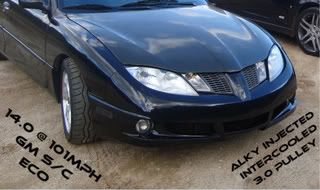is there a thread with hahns motor build? Ive searched but cant find anything. im specifically interested in the bedplate conversion.
thanks guys
"
Kick azz is my boost hero!!! 
"

damnit, and here i thought i was about to whitness the whole build in this thread

...way to let me down

Jcavi wrote:is there a thread with hahns motor build? Ive searched but cant find anything. im specifically interested in the bedplate conversion.
thanks guys
bedplate conversion..?

you know ecotecs are all bedplates, right....?
Edited 1 time(s). Last edited Friday, May 08, 2009 3:05 PM

Just grab a GMPP build book. All the info and part numbers are there.
I have one and don't even own an Ecotec

Jason
99 Z24 Supercharged
157hp/171tq - NA
190hp/170tq @ 6psi
LG0/LD9 for Life

wtf is a 'bedplate'?

I'm tired of wasting my time... now I'm breakin' free.
Bedplate or main bearing girdle.

ohhhhhhhhhhhhhhhhhhhhh

I'm tired of wasting my time... now I'm breakin' free.
z yaaaa wrote:wtf is a 'bedplate'?
bedplate is a term (also girdle is used) to refer to how the crankshaft is fastened into place in the block.
all ecotec blocks are basically cut in half with the crankshaft sandwiched inbetween. the bedplate provides support for the crankshaft, as well as the block, and helps to bear the stress of the rotating assembly.
bedplates are the preferred method of use in most forms of racing. they have conversion kits for most conventional 'mains' engines.. but the ecotec needs no such thing because it already has this design from the factory.
so instead of having to worry about upgrading the main caps, the eco is one giant assembly, with 6 bolts in each bulkhead (could be called 6-bolt mains)

in his profile he mentions something about some bedplate work he did. im just wondering what was done to it.
"
Kick azz is my boost hero!!! 
"

Jcavi wrote:in his profile he mentions something about some bedplate work he did. im just wondering what was done to it.
so I looked it up in Adam's profile...
Adams profile wrote:Bedplate bolt to Stud conversion
Jcavi.. no offense man, but.. god damn...

"bolt to stud conversion" means that instead of bolts for the bedplate, they used studs.
like, instead of headbolts, they use headstuds... same principal but on the bedplate/girdle instead of the head.
english?


For hahn's basic block setup see
this thread more specifically pages 8 and 9 highlight the block...
---------------------------------------------------
4 Cams...32 Valves...5 Liters...This Could Get Fun!

The block has ARP (I believe don't quote me on them being an ARP product) studs going through the bottom half of the block as oppose to bolts. Reason? You should upgrade the bolts anyways when going to high boost levels and a stud/nut combination is much stronger and can take more torque than a bolt. It's really a "plug and play" system, remove the bolt, and insert a stud. We had to slightly modify the oil pan because 3 of the studs were like a thread too long.

Street-Legal 2003 Sunfire 10.58 @ 139 MPH
Adam Hahn wrote:Reason? You should upgrade the bolts anyways when going to high boost levels and a stud/nut combination is much stronger and can take more torque than a bolt.
That is wrong. That is not the reason to use studs. Strength and torque are equal between studs and bolts. Torque is a function of thread pitch, fastener diameter, and more typically limited by the materials being fastened. Torque is not a function of fastener type at all. Strength is also not a function of fastener type either, rather strength is limited to the tensile stress of the fastener and again typically the weak point is the materials being fastened. Both studs and bolts can be made of the same material, diameter, and thread pitch.
The REAL reason to use studs is because it gives you the ability to thread the stud all the way to the bottom of the threads that are cut into the female bore hole, then tightened from the top using a nut. This is not possible with a bolt since the bolt threads as it drops into the hole and tolerances what they are, you not going to seat a bolt at the very bottom of the threaded hole just as you achieve required torque to make up the fastener. Typically you will see bolts thread to within 0.25" of the bottom of the bore hole and not much closer where studs can reach all the way to the bottom.
"Never argue with an idiot. They'll drag you down to their level, then beat you with experience!" -Anonymous
Joshua, while everything you said is infact true, my statement that a stud/nut combo is stronger than a bolt is correct, but maybe a bit too broad. Fact is, with a stud you can choose the pitch size you want on the threads of the end recieving the nut and as such you can get a more suitable torque spec for given application. Also, I have never had a nut snap off a stud, where i've seen many bolt heads snap right off of a bolt when high amounts of torque is applied like in the bedplate of a motor

.

Street-Legal 2003 Sunfire 10.58 @ 139 MPH
Well, you forgetting another key part of thread torque make up. A fine thread compared to a coarse thread requires more torque on the nut to achieve the same 'tightness' of the stud due to the higher interface tension on the threads. A course thread which has less interface requires less torque applied in making up the fastener because it has less interface. So really, although the torque may change 10-20 ft/lbs on the nut at the top of the stud, the actual 'tightness' is exactly the same and most always limited by the materials being fastened. Don't forget that. That is why you see higher torque rating for fine threads, not for any other reason.
Bolt heads fly off when they are manufactured incorrectly, that is all. Sure, you might have better reliability with studs, but that's not because they are stronger. The materials can be the same. Bolts that don't have a flat mating surface on the bottom of the head is what causes them to have stress concentrations, this can also be caused by the mating materials not being flat either. Studs however can bend at the nut/stud interface giving a little bit more give in the system but this again is detrimental to the life of the stud as centralized stress cracks can begin forming at the interior of the bend. Although you may not see them, they can exist. So its a give and take, one risk for another. They key is properly made bolts and nice flat mating surfaces on the pieces being fastened. If that is achieve, both bolts and studs are EXACTLY the same as far as strength goes. Obviously you still have the main and only advantage of studs vs. bolts which is the thread depth.
EDIT: spelling
Edited 4 time(s). Last edited Monday, May 18, 2009 10:29 PM
"Never argue with an idiot. They'll drag you down to their level, then beat you with experience!" -Anonymous
i guess i just never put two and two together. i swear I read just the words " bedplate conversion" and nothing about it being from bolts to studs.
"
Kick azz is my boost hero!!! 
"











